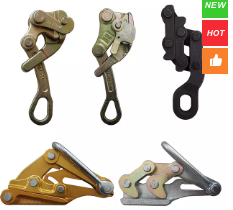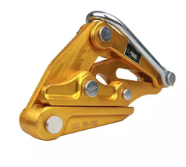
Introduction
A come along is an essential hand-operated tool that helps you move, lift, or secure heavy objects with ease and minimal effort. Its mechanical design enables a single user to apply significant force, which would otherwise require heavy machinery or more labor-intensive methods. This article will explore the different types of come alongs, how to operate them, and their wide range of applications in industries such as construction, automotive, and everyday tasks. Whether you're a professional or a DIY enthusiast, a come along is a valuable tool to have in your toolkit.
What Is a Come Along?
A come along is a mechanical winch tool used for pulling, lifting, or securing heavy objects. It uses a system of cables or straps, combined with a ratchet mechanism, to provide significant mechanical advantage. This allows the user to move objects much heavier than what could be handled with simple human force alone. Typically, come alongs are manual tools, meaning they don’t require external power sources like electricity or fuel. This makes them incredibly useful in remote or confined spaces where power equipment might not be practical.
In addition to its manual operation, another key benefit of the come along is its portability. Unlike large industrial machinery or powered winches, the come along is lightweight and can easily be transported from job to job. It’s ideal for use in a variety of industries, including construction, automotive repair, agriculture, and even for recreational activities like towing vehicles from ditches.
The Mechanics Behind a Come Along
The basic design of a come along tool consists of three main parts: a ratchet mechanism, a cable (or strap), and an anchor point. The cable is wound around a spool, and when the user operates the handle, the ratchet mechanism engages, causing the cable to tighten. This creates tension that moves or secures the load. The ratchet system is essential, as it allows the cable to be tightened incrementally, providing the necessary pulling force.
The mechanical advantage provided by a come along is what makes it so effective. The tool is designed to multiply the force exerted by the user, enabling them to pull heavy objects with minimal effort. Whether it's pulling a car out of a ditch or lifting construction materials, the come along allows for tasks that would otherwise require more expensive or power-intensive equipment.
The History of the Come Along Tool
The come along tool has been around for many decades, and its development traces back to the early days of mechanical winches and pulling devices. Historically, people relied on simple pulley systems to move heavy objects. These systems, while effective, required a significant amount of manual labor and were not always efficient when it came to lifting or pulling heavy loads over long distances.
The modern come along emerged as a solution to the limitations of earlier systems. It incorporated the use of a ratchet mechanism to create incremental pulling force, allowing one person to pull large items, which would otherwise require a team of workers or larger equipment. Early come alongs were mostly used in industries like logging, where large trees or logs needed to be moved over long distances. Over time, the tool was adopted by the construction industry, automotive professionals, and even hobbyists who required a tool that could easily move large objects.
In the years since its invention, the come along has seen numerous improvements. These innovations include the use of hydraulic power for heavy-duty tasks, the incorporation of electric motors for continuous use, and the use of stronger materials like synthetic straps and cables. Despite these advancements, the basic principle of the come along has remained the same, making it a timeless and indispensable tool.
Types of Come Alongs
There are several types of come alongs, each with its own specific features and ideal use cases. Below is a comprehensive breakdown of the different types of come alongs that are commonly available:
1. Cable Come Along
The cable come along is the most widely used type of come along. It utilizes a steel cable that is wound around a drum and operated by a ratchet mechanism. The steel cable is strong, durable, and can be used to pull heavy loads over longer distances.
Pros:
· High pulling capacity: Perfect for moving or lifting heavy loads.
· Durability: Steel cables are strong and resistant to wear and tear, which is essential for heavy-duty use.
· Versatility: Suitable for towing vehicles, lifting construction materials, or securing loads.
Cons:
· Heavy and bulky: It may not be as portable or lightweight as some other types.
· Maintenance required: Steel cables need to be inspected regularly for rust and wear, especially when used in outdoor or wet environments.
2. Strap Come Along
Strap come alongs use a heavy-duty strap, typically made from synthetic materials such as polyester or nylon, instead of a steel cable. These come alongs are lighter and offer the advantage of being less likely to cause damage to the object being moved, such as delicate machinery or furniture. Strap come alongs are commonly used for lighter-duty tasks compared to cable come alongs.
Pros:
· Lighter and more portable: Easier to transport and handle.
· Non-damaging: The strap is less likely to cause scratches or other damage to the object being moved.
· Ideal for lighter loads: Great for use with vehicles or equipment in non-industrial applications.
Cons:
· Lower pulling capacity: Not suitable for moving extremely heavy objects.
· Strap may stretch: Under high tension, straps can stretch, reducing their effectiveness.
3. Ratchet Come Along
A ratchet come along operates similarly to the cable come along but features an automatic locking mechanism that engages after each pull. This system allows for more consistent tension without the need for constant manual adjustments. It is ideal for tasks that require steady and controlled pulling, such as securing loads during transport.
Pros:
· Provides steady and consistent pulling force: Once the ratchet engages, it locks into place, making it easy to maintain constant pulling force.
· Easier to operate: Reduces the amount of manual effort needed compared to non-ratchet models.
· Ideal for one-person operation: Can be operated by a single user, making it efficient and convenient.
Cons:
· Heavier: Ratchet come alongs tend to be bulkier than non-ratchet models.
· More expensive: The added mechanism makes these models more costly.
4. Hydraulic Come Along
Hydraulic come alongs use hydraulic power to provide significantly more pulling power than manual models. They are ideal for tasks that require moving extremely heavy objects, such as large machinery or vehicles. These tools are commonly used in industrial or heavy-duty environments.
Pros:
· Very powerful: Capable of handling the heaviest loads.
· Less manual effort required: Hydraulic pressure does most of the work, reducing operator fatigue.
· Ideal for industrial applications: Used in construction, automotive, and other sectors that require large-scale lifting or pulling.
Cons:
· Expensive: Hydraulic models are typically much more costly than manual come alongs.
· Requires maintenance: Hydraulic systems need regular maintenance to ensure optimal performance.
· Less portable: These models are heavier and less mobile than their manual counterparts.
5. Electric Come Along
An electric come along uses an electric motor to drive the winch, making it ideal for continuous operation without manual effort. These models are commonly used for towing and recovery tasks where consistent pulling is required, such as when recovering vehicles or moving large machinery over long distances.
Pros:
· Powerful and efficient: Electric motors provide continuous pulling force without the need for manual operation.
· Reduces operator fatigue: Eliminates the physical strain that comes with using a manual come along.
· Ideal for large-scale tasks: Suitable for applications requiring prolonged or heavy-duty use.
Cons:
· Expensive: Electric models are significantly more expensive than manual versions.
· Requires a power source: Electricity or battery power is necessary, which can limit portability.
· Heavier: The electric motor adds weight, making the tool less portable.

How to Use a Come Along
Using a come along properly is crucial to completing tasks safely and efficiently. Here’s a step-by-step guide on how to operate a come along:
1. Inspect the Tool
Before using a come along, always inspect the tool thoroughly. Check for any signs of damage, particularly the cable or strap. Make sure the ratchet mechanism is functioning smoothly and that all parts are securely attached.
2. Secure the Anchor Point
The next step is to find a solid anchor point to attach the come along. This could be a tree, a vehicle, or any other stationary structure capable of withstanding the pulling force. Ensure that the anchor is secure and will not move during the operation.
3. Attach the Load
Connect the other end of the cable or strap to the load you want to move. Use appropriate hardware, such as hooks or shackles, to secure the load firmly. For example, when recovering a vehicle, attach the hooks to the vehicle’s frame or designated towing points.
4. Operate the Ratchet
With everything connected, begin pulling the handle of the come along. This will engage the ratchet mechanism, tightening the cable or strap and starting to move the load toward the anchor point. Be sure to pull gradually and monitor the load as it moves.
5. Monitor the Load
As the load moves, watch closely to ensure that it is moving in the desired direction. Avoid overloading the tool, and stop if you notice any signs of strain or instability. Always ensure that the load is secure before continuing.
6. Secure the Load
Once the load reaches its desired position, disengage the ratchet mechanism and secure the load to prevent any further movement. If you need to release tension, use the reverse mechanism (if available) to slowly unwind the cable or strap.
Conclusion
In conclusion, the come along is a highly versatile, effective, and cost-efficient tool that provides the mechanical advantage needed to pull, lift, and secure heavy loads. Its simple design, combined with its ability to generate significant force, makes it an essential tool for many industries and applications. By understanding the different types of come alongs, their features, and how to use them properly, you can ensure that you’re equipped to handle any task that requires lifting, towing, or securing heavy objects.
For professionals and DIY enthusiasts looking for high-quality and durable come along tools, JITAI Electric Power Equipment Co., Ltd. is a leading manufacturer known for producing reliable and efficient products. Whether you’re dealing with light-duty or heavy-duty tasks, JITAI Electric Power Equipment Co., Ltd. ensures that their come alongs meet the highest standards of performance. Their tools are designed to provide reliable and consistent results in any environment, helping professionals and DIY enthusiasts alike. Their commitment to quality ensures that you’ll always get top-notch tools that deliver superior performance.
FAQ
What is the purpose of a come along?
A come along is designed to pull, lift, or secure heavy loads by providing a mechanical advantage. It is used in a variety of tasks, such as towing vehicles, lifting equipment, and securing items during transportation.
What is the difference between a come along and a winch?
The primary difference is the power source. A come along is manually operated, while a winch can be electric, hydraulic, or engine-powered. Winches are generally more powerful and are designed for continuous operation, whereas come alongs are typically used for smaller tasks and are more portable.
How does a come along tool work?
A come along operates by engaging a ratchet mechanism to tighten a cable or strap. The tension generated pulls the load toward a fixed anchor point, moving or securing it in place.
Is a cable puller the same as a come along?
While both are used for pulling tasks, a cable puller is typically designed for use in electrical or construction work, while a come along is used more widely in various industries and applications.

















